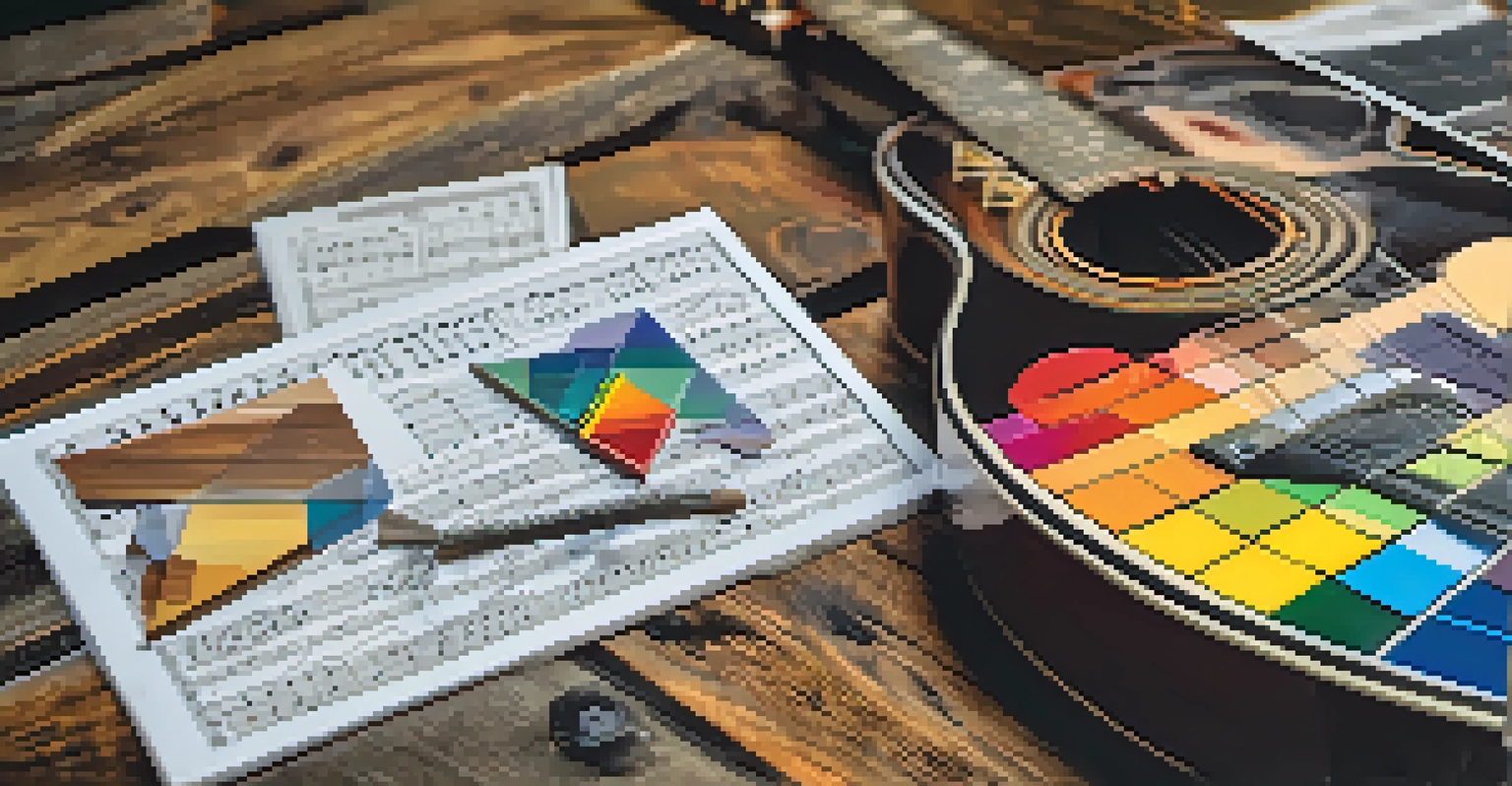Understanding Chord Progressions in Guitar Composition

What Are Chord Progressions and Why They Matter
Chord progressions are sequences of chords played in a specific order, forming the backbone of most songs. They create the harmonic structure that supports melodies, giving depth and emotion to the music. Understanding how these progressions work is crucial for any guitarist looking to compose original pieces.
Music is the shorthand of emotion.
When you think about your favorite songs, chances are you can recall the chord changes that made them memorable. These progressions can evoke feelings ranging from joy to sadness, shaping the listener's experience. By mastering chord progressions, you unlock new creative possibilities in your guitar playing.
So, whether you’re strumming a simple tune or crafting a complex composition, knowing how to use chord progressions effectively can elevate your music. They serve as a foundation upon which you can build intricate melodies and harmonies, making your compositions stand out.
Common Chord Progressions Every Guitarist Should Know
Some chord progressions are so widely used that they have become staples in music. For instance, the I-IV-V progression is a classic found in countless rock and pop songs. This pattern involves the first, fourth, and fifth chords of a key and creates a strong, catchy foundation for your music.

Another popular progression is the I-vi-ii-V, often heard in jazz and doo-wop music. It adds a touch of sophistication while still being easy to play on guitar. By familiarizing yourself with these common progressions, you can quickly start writing songs that resonate with audiences.
Chord Progressions Enhance Music
Understanding chord progressions is essential for guitarists, as they form the emotional and harmonic backbone of songs.
Simply put, knowing these progressions not only enhances your playing but also gives you a toolbox for songwriting. You can mix and match them, add your twist, and create something uniquely yours, all while standing on the shoulders of musical giants.
How to Analyze Chord Progressions in Your Favorite Songs
Analyzing your favorite songs can be a fantastic way to learn about chord progressions. Start by listening closely and trying to identify the chords being played. You can use a guitar or piano to replicate the sounds, which will help you understand how the progression contributes to the overall feel of the song.
The only thing better than singing is more singing.
Take notes on the structure of the song—how it introduces the chords, transitions, and resolves. This practice not only improves your ear for music but also gives you insight into the techniques used by successful songwriters. By dissecting these elements, you can apply similar strategies in your compositions.
Remember, every great musician was once a student of the craft. By learning from the songs you love, you can infuse those lessons into your own guitar playing, leading to a deeper understanding of how to create impactful music.
Experimenting with Chord Progressions for Creativity
Once you're comfortable with common chord progressions, it’s time to unleash your creativity. Don’t hesitate to experiment by altering existing progressions or combining elements from different genres. This can lead to fresh sounds and unexpected musical journeys.
For example, try taking a classic I-IV-V progression and inserting a minor chord for a surprising twist. This simple change can evoke entirely different emotions in your music. The key is to keep an open mind and allow yourself to play around with various combinations until something resonates with you.
Common Progressions for Songwriting
Familiarity with staple chord progressions like I-IV-V and I-vi-ii-V equips musicians with a toolbox for creating resonant songs.
Ultimately, experimentation is where the magic happens. The more you explore, the more you'll find your unique voice as a guitarist, leading to compositions that truly reflect your personality and artistic vision.
Using Chord Progressions to Set the Mood
Different chord progressions can evoke specific emotions, allowing you to set the mood for your piece. For example, major chords often create a happy and uplifting vibe, while minor chords tend to convey sadness or introspection. Understanding this can help you choose the right progression for the message you want to express.
Consider the classic I-IV-V progression; it’s upbeat and energetic, perfect for a celebratory song. On the other hand, a ii-V-I progression in a minor key can produce a more reflective and somber atmosphere. Your choice of chords can guide your listeners through a range of emotions, enhancing their connection to your music.
By being intentional with your chord progressions, you can craft songs that resonate deeply with your audience. This emotional resonance is what makes music powerful, transforming simple notes into a shared experience.
The Role of Rhythm in Chord Progressions
While chords lay the foundation, rhythm adds life to your progressions. The way you strum or pick your chords can drastically change the feel of a song. For instance, a steady strumming pattern can establish a driving force, while a broken chord pattern creates a more delicate texture.
Experimenting with different rhythms can also help you discover new progressions. A simple change in timing can turn a familiar sequence into something entirely fresh and exciting. Think of it this way: rhythm is the heartbeat of your music, giving it energy and movement.
Experimenting Fuels Creativity
Experimenting with chord progressions and rhythms allows guitarists to discover their unique musical voice and express their artistic vision.
By integrating rhythm into your chord progressions, you unlock a world of possibilities in your compositions. It's not just about what chords you play, but how you play them that makes all the difference in the emotional impact of your music.
Tips for Writing Your Own Chord Progressions
Writing your own chord progressions might seem daunting, but it can be incredibly rewarding. Start by choosing a key and experimenting with the chords within that scale. Don’t be afraid to mix major and minor chords, as this contrast can lead to interesting results.
Another tip is to listen to the natural flow of your progressions. Play around with the order of your chords or add in unexpected transitions to keep things fresh. Sometimes, the best ideas come from trial and error, so allow yourself the freedom to explore.

Finally, keep your audience in mind. Think about what emotions you want to evoke and choose your chords accordingly. By combining your creative instincts with thoughtful choices, you’ll craft progressions that not only sound good but also resonate deeply with your listeners.